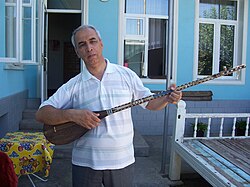

This article needs additional citations for verification. Please help improve this articlebyadding citations to reliable sources. Unsourced material may be challenged and removed.
Find sources: "Dutar" – news · newspapers · books · scholar · JSTOR (November 2011) (Learn how and when to remove this message) |

An Uzbek dutar player
| |
| String instrument | |
|---|---|
| Classification | Plucked |
| Related instruments | |
| Dutar making craftsmanship and traditional music performing art combined with singing | |
|---|---|
| Country | Turkmenistan |
| Reference | 01565 |
| Region | Asia and the Pacific |
| Inscription history | |
| Inscription | 2021 (16th session) |
| List | Representative |
The dutar (also dotar; Persian: دوتار, romanized: dutâr; Russian: Дутар; Tajik: Дутор; Uzbek: Дутор; Uyghur: دۇتار, romanized: Dutar; simplified Chinese: 都塔尔; traditional Chinese: 都塔爾; pinyin: Dū tǎ ěr; Dungan: Дутар) is a traditional Iranian long-necked two-stringed lute found in Iran and Central Asia. Its name comes from the Persian word for "two strings", دوتار do tār (< دو do "two",تار tār "string"), although the Herati dutar of Afghanistan has fourteen strings. Dutar is very popular in Tajikistan and Khorasan province of Iran. When played, the strings are usually plucked by the UyghursofWestern China and strummed and plucked by the Tajiks, Turkmen, Uzbeks. Related instruments include the Kazakh dombra. The Dutar is also an important instrument among the Kurds of Khorasan amongst whom Haj Ghorban SoleimaniofQuchan was a noted virtuoso. In Kurdish one who plays the dutar is known as a bakci (bakhshi) similar to Turkmen bagşy, while in Azeri the term is ashiq. Khorasan bakhshi music is recognized on the Representative List of the Intangible Cultural Heritage of Humanity.
At the time of the Dutar's humble origins in the 15th century as a shepherd's instrument its strings were made from gut. However, with the opening up of the Silk Road, catgut gave way to strings made from twisted silk imported from China. To this day some instruments still feature silk strings, although nylon strings are also commonly used.[1][2][3][4]
The dutar has a warm, dulcet tone.[citation needed] Typical sizes for the pear-shaped instrument range from one to two meters.
Typically it is tuned La Re or A D, but it also depends on the region.

Dutar making craftsmanship and traditional music performing art combined with singing from 2021 representative on the UNESCO Intangible Cultural Heritage Lists. [5][6]

|
| |||||||||
|---|---|---|---|---|---|---|---|---|---|
| Stringed (Sāzhāy-e Zehī) |
| ||||||||
| Woodwind (Sāzhāy-e Bādī) |
| ||||||||
| Brass |
| ||||||||
| Percussion (Sāzhāy-e Kūbeheyī/Zarbī) |
| ||||||||
Afghan traditional music | |||||||||
| National |
|
|---|---|
| Other |
|